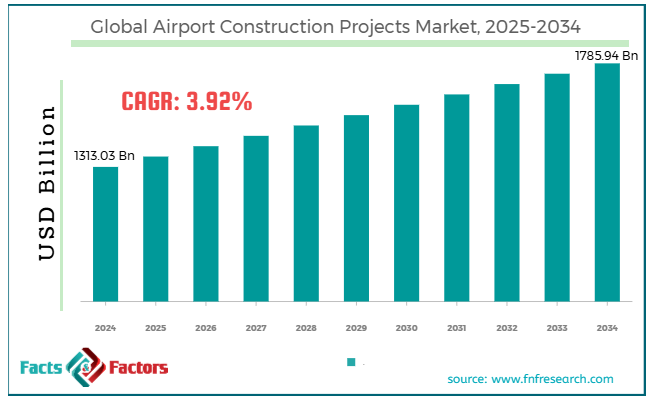Search Market Research Report
Airport Construction Projects Market Size, Share Global Analysis Report, 2025 – 2034

Airport Construction Projects Market Size, Share, Growth Analysis Report By Funding (Public, Private, Hybrid), By Application (Defense & Military, Commercial & Civil), And By Region - Global Industry Insights, Overview, Comprehensive Analysis, Trends, Statistical Research, Market Intelligence, Historical Data and Forecast 2025 – 2034
Industry Insights
[221+ Pages Report] According to Facts & Factors, the global airport construction projects market size was worth around USD 1313.03 billion in 2024 and is predicted to grow to around USD 1785.94 billion by 2034, with a compound annual growth rate (CAGR) of roughly 3.92% between 2025 and 2034.

 Market Overview
Market Overview
Airport construction projects comprise the design, planning, and building of new airports or the growth and innovations in the present ones to meet the elevating air travel needs. These projects usually contain building terminals, runways, parking structures, supporting facilities, and control towers, as well as incorporating improved technologies for safety, sustainability, and efficiency. The worldwide airport construction projects market is anticipated to progress remarkably over the coming years due to the mounting passenger traffic, rapid economic growth and urbanization, technological improvements, and supportive governmental initiatives.
The steady rise in universal passenger numbers demands upgraded and expanded airport infrastructure to satisfy the increasing demand. Economic development and urbanization trends in developing economies are driving the expansion of existing infrastructure, and new airports are needed to support the growing tourism, business travel, and trade.
Moreover, modernizations like digitalization, automation, and smart technologies at airports fuel capitalization to improve airport systems by advancing safety, passenger travel experience, and efficiency. In addition, programs that contribute to regional connectivity boost infrastructural development by operationalizing several routes and opening airports.
Nevertheless, the global industry faces restrictions due to funding, space, and land restrictions. Financing challenges and restricted public funding majorly hamper the projects of large-scale airport infrastructure, leading to cancellations or delays of expansion activities.
Moreover, in densely populated regions, the acquisition of land for the expansion of airports is generally challenging and costly, thus restricting infrastructure development. Yet, the global airport construction projects industry is expected to grow notably, backed by infrastructure modernization and public and private associations. Several opportunities exist for upgrading the present infrastructure with improved solutions, efficient operational systems, sustainable practices, and technologies.
Also, associations between private investors and government agencies provide prospects for funding and delivering airport systems projects via advanced funding models. The emphasis on eco-friendly and sustainable infrastructure solutions, comprising renewable energy incorporation, energy-efficient buildings, and reduction in carbon emissions, offers opportunities for green investments and innovations.
 Key Insights:
Key Insights:
- As per the analysis shared by our research analyst, the global airport construction projects market is estimated to grow annually at a CAGR of around 3.92% over the forecast period (2025-2034)
- In terms of revenue, the global airport construction projects market size was valued at around USD 1313.03 billion in 2024 and is projected to reach USD 1785.94 billion by 2034.
- The airport construction projects market is projected to grow significantly due to the increasing air passenger traffic, expanding economic development and urbanization, and strict security, safety, and environmental sustainability regulations.
- Based on funding, the public segment is expected to lead the market, while the private segment is expected to grow considerably.
- Based on application, the commercial & civil segment is the dominating segment among others, while the defense & military segment is projected to witness sizeable revenue over the forecast period.
- Based on region, North America is projected to dominate the global market during the estimated period, followed by the Asia Pacific.
 Growth Drivers
Growth Drivers
- Regional urbanization and development spur market growth
With the increasing population and growth of cities, airport development is a vital enabler of improved mobility, regional economic growth, and higher global connectivity. Airport infrastructural development is essential for enhancing access to worldwide markets in speedily developing regions like Africa and the Asia Pacific.
Modern or new airports are being built to promote regional tourism and business hubs in nations like Brazil, China, and India. China's Beijing Daxing International Airport is the best example of how airport growth complies with the country’s wider economic growth plans. It is projected to manage 72 million passengers yearly, with the capability to progress more in the coming years.
Several airports are being incorporated into wider urban development plans, with the development of neighboring commercial, retail, and residential spaces. For instance, Dubai World Central Airport is part of a larger urban development plan that includes hotels, housing, and industrial zones, making it a key driver of regional development.
- What technological improvements in airport operations will fuel the growth of the airport construction projects market?
The rising role of technology in the aviation market is changing the operations of airports and fueling the demand for improved construction projects.
Airports are welcoming solutions like automation, IoT, and robotics. These improvements reduce waiting times, enhance security, and boost airport operations. For instance, Dubai International Airport launched biometric boarding systems that enable passengers to use facial recognition to board flights, simplifying check-in procedures.
Airports are also using building information modeling for enhanced construction planning and design. BIM enables construction groups to imitate and envision every factor of airport infrastructure before breaking ground, thereby aiding in delays and reducing construction errors. These efforts are expected to impact the global airport construction projects industry’s progress.
 Restraints
Restraints
- How will delays in project timelines negatively impact the airport construction projects market progress?
Delays in airport construction projects are growing more common, primarily due to regulatory obstacles, logistical challenges, and unanticipated complications. Projects like Spain's Region de Murcia International Airport and the UK's Heathrow third runway have witnessed significant delays due to regulatory challenges and ecological concerns.
Besides, Los Angeles' LAX Automated People Mover project experienced key delays, with the inauguration planned in January 2026, following a delay from its initial 2023 launch date. This is backed by incorporation stresses and construction hindrances, costing an extra USD 600 million.
 Opportunities
Opportunities
- Will urban air mobility and eVTOL networks present growth opportunities for the airport construction projects market?
Urban air mobility is transforming how people think about traveling, offering fresh avenues in airport construction. It comprises the development of eVTOL (electric, vertical take-off, and landing airplanes specially designed for urban air transport. Specially dedicated vehicles, such as air taxis, increase on-demand air travel while significantly decreasing travel times in overcrowded metropolitan regions.
The development of urban air mobility networks offers significant opportunities for construction companies, airport authorities, and technology providers, with the capability to majorly change urban transportation's outlook. Several cities on a global scale are initiating plans for activities and projects at modern airports or hubs for eVTOL services, impacting the progress of the airport construction projects market.
 Challenges
Challenges
- Compliance delays and environmental regulations limit the growth of the market
Ecological examinations and adhering to regulations are necessary, but they usually lead to significant delays in airport construction plans. It extends timelines and increases costs, thereby affecting operations. Runway construction activities, for example, are witnessing mediocre delays of nearly 36 months because of ecological compliance needs. These delays mostly lead to 25-30% cost ravages, distracting funds from essential infrastructure upgrades. These delays result in airports functioning at lower capacities, worsening inefficiencies and overcrowding.
 Report Scope
Report Scope
Report Attribute |
Details |
Market Size in 2024 |
USD 1313.03 Billion |
Projected Market Size in 2034 |
USD 1785.94 Billion |
CAGR Growth Rate |
3.92% CAGR |
Base Year |
2024 |
Forecast Years |
2025-2034 |
Key Market Players |
Bechtel Corporation, Vinci Construction, Ferrovial, Fluor Corporation, TAV Construction, Hochtief AG, Larsen & Toubro (L&T), Samsung C&T Corporation, AECOM, Turner Construction Company, Bouygues Construction, BAM International, Shanska USA Building Inc., GMR Group, Clark Construction Group, and others. |
Key Segment |
By Funding, By Application, and Region |
Major Regions Covered |
North America, Europe, Asia Pacific, Latin America, and the Middle East &, Africa |
Purchase Options |
Request customized purchase options to meet your research needs. Explore purchase options |
 Segmentation Analysis
Segmentation Analysis
The global airport construction projects market is segmented based on funding, application, and region.
The global airport construction projects industry is divided into public, private, and hybrid based on funding. The public funding segment registered the maximum market share in the past years. The signet will gain substantial progress over the estimated period owing to the strong government's key role in funding large-scale infrastructure projects.
Governments worldwide recognize the strategic importance of enhancing airport infrastructure to foster economic growth, boost tourism, and improve connectivity. The public funds are usually apportioned to expand the present airports, construct novel facilities, and incorporate modern technologies to improve passenger services and operational efficiency.
Governments also use official development assistance grants and loans to finance these large-scale airport plans. The Vietnamese government has distributed significant public funds and gained ODA loans to develop a massive airport project. Private funds are used to build passenger terminals.
Based on application, the global airport construction projects market is segmented into defense & military and commercial & civil. The commercial & civil segment captured the maximum market share due to steady investments by private and airlines, emphasis on airport operations, and government initiatives. Significant investments are being made in airport expansion by private investors and airlines to improve operational efficiency and passenger experience. There is a surging focus on infrastructure upgrades to house the mounting passenger traffic and large aircraft.
Governments are taking initiatives to enhance regional and national connectivity, military logistics, and disaster management. The segment comprises a broad range of plans and projects, including runway, terminal expansions, and the incorporation of improved technologies to simplify operations.
 Regional Analysis
Regional Analysis
- What factors help North America lead the global airport construction projects market?
North America held a leading share of the worldwide airport construction projects market in 2024 and is projected to lead in the future, backed by significant investments in infrastructure, government initiatives and funding, key projects, and emphasis on efficiency and safety. North America holds the market's most crucial share, with an estimated USD 142.5 billion by 2024, registering roughly 24% of the total.
Moreover, the United States Department of Transportation apportioned USD 243.7 million last year to aid airport infrastructure plans in 37 states, emphasizing safety improvements, modernization, and employment generation. Airports in the region are planning significant investments with roughly USD 6 billion for infrastructural advancements in 2024. This comprises runway improvements, terminal development, and the incorporation of modernized baggage handling systems.
Furthermore, many airports are undergoing extensive upgrades, including a USD 3 billion terminal improvement, to enhance operational efficacy and passenger experience. Projects like 'the USD 40 million runway improvement' for Houston’s William P. Hobby Airport are advancing operational and safety standards, complying with their federal protocols.
Asia Pacific held a second-leading position in the global airport construction projects industry owing to significant investments in airport arrangement, current major projects, and rising air travel demand. The region leads globally with USD 488 billion capitalization in 575 airport plans.
Remarkably, Southeast Asia registers for 60% of newly designed airport projects, with nations like Vietnam aiming for 30 projects and others, including Malaysia, Thailand, Philippines, Cambodia, Indonesia, and Singapore, extending their present ones. Significant developments from nations like Singapore, the Philippines, and Vietnam aim to enhance capacity and streamline congestion.
Moreover, Asia Pacific's pipeline of airport construction is estimated at USD 241.4 billion, with the Philippines and China leading, followed by Hong Kong and India. The region's surging air travel, higher spending power of consumers, and growing middle-class population are fueling the growth of air travel. Southeast Asia's passenger quantity is projected to surpass USD 653 million by 2023, doubling and amplifying from 2023.
 Competitive Analysis
Competitive Analysis
The global airport construction projects market is led by players like:
- Bechtel Corporation
- Vinci Construction
- Ferrovial
- Fluor Corporation
- TAV Construction
- Hochtief AG
- Larsen & Toubro (L&T)
- Samsung C&T Corporation
- AECOM
- Turner Construction Company
- Bouygues Construction
- BAM International
- Shanska USA Building Inc.
- GMR Group
- Clark Construction Group
 Key Market Trends
Key Market Trends
- Flexible design and modular construction:
Modular construction methods, comprising prefabricated parts, enable cost-effective and faster airport development and innovations. This trend aids future growth and adaptability to changing travel needs.
- Better passenger experience through technology:
Airports are emphasizing enhancements in passenger experience by integrating digital check-ins, wellness facilities, and contactless security. Solutions like augmented reality, biometrics, and more are used to create smooth and personalized travel experiences.
The global airport construction projects market is segmented as follows:
 By Funding Segment Analysis
By Funding Segment Analysis
- Public
- Private
- Hybrid
 By Application Segment Analysis
By Application Segment Analysis
- Defense & Military
- Commercial & Civil
 By Regional Segment Analysis
By Regional Segment Analysis
- North America
- The U.S.
- Canada
- Mexico
- Europe
- France
- The UK
- Spain
- Germany
- Italy
- Rest of Europe
- Asia Pacific
- China
- Japan
- India
- Australia
- Southeast Asia
- Rest of Asia Pacific
- The Middle East & Africa
- Saudi Arabia
- UAE
- Egypt
- Kuwait
- South Africa
- Rest of the Middle East & Africa
- Latin America
- Brazil
- Argentina
- Rest of Latin America
Industry Major Market Players
- Bechtel Corporation
- Vinci Construction
- Ferrovial
- Fluor Corporation
- TAV Construction
- Hochtief AG
- Larsen & Toubro (L&T)
- Samsung C&T Corporation
- AECOM
- Turner Construction Company
- Bouygues Construction
- BAM International
- Shanska USA Building Inc.
- GMR Group
- Clark Construction Group
Frequently Asked Questions

Copyright © 2024 - 2025, All Rights Reserved, Facts and Factors


